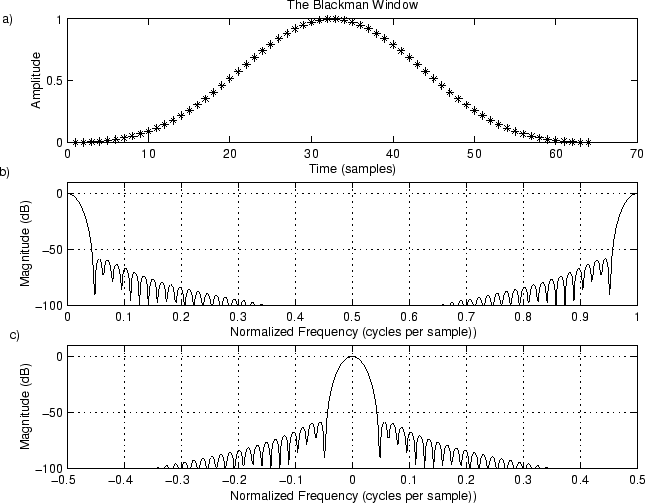NOTE: THIS DOCUMENT IS OBSOLETE, PLEASE CHECK THE NEW VERSION: "Mathematics of the Discrete Fourier Transform (DFT), with Audio Applications --- Second Edition", by Julius O. Smith III, W3K Publishing, 2007, ISBN 978-0-9745607-4-8. - Copyright © 2017-09-28 by Julius O. Smith III - Center for Computer Research in Music and Acoustics (CCRMA), Stanford University
<< Previous page TOC INDEX Next page >>
Example 4: Blackman Window
Finally, to finish off this sinusoid, let's look at the effect of using aBlackman window (which has nice but suboptimal parameters for audio work). Figure 9.5a shows the Blackman window, Fig. 9.5b shows its magnitude spectrum on a dB scale, and Fig. 9.5c introduces the use of a more natural frequency axis which interprets the upper half of the bin numbers as negative frequencies. Here is the Matlab for it:
% Add a "Blackman window" % w = blackman(N); % if you have the signal processing toolbox w = .42-.5*cos(2*pi*(0:N-1)/(N-1))+.08*cos(4*pi*(0:N-1)/(N-1)); figure(5); subplot(3,1,1); plot(w,'*'); title('The Blackman Window'); xlabel('Time (samples)'); ylabel('Amplitude'); text(-8,1,'a)');
% Also show the window transform: xw = [w,zeros(1,(zpf-1)N)]; % zero-padded window (col vector) Xw = fft(xw); % Blackman window transform spec = 20log10(abs(Xw)); % Spectral magnitude in dB spec = spec - max(spec); % Usually we normalize to 0 db max spec = max(spec,-100*ones(1,nfft)); % clip to -100 dB subplot(3,1,2); plot(fni,spec,’-’); axis([0,1,-100,10]); grid; xlabel(‘Normalized Frequency (cycles per sample))’); ylabel(‘Magnitude (dB)’); text(-.12,20,‘b)’);
% Replot interpreting upper bin numbers as negative frequencies: nh = nfft/2; specnf = [spec(nh+1:nfft),spec(1:nh)]; % see also Matlab’s fftshift() fninf = fni - 0.5; subplot(3,1,3); plot(fninf,specnf,’-’); axis([-0.5,0.5,-100,10]); grid; xlabel(‘Normalized Frequency (cycles per sample))’); ylabel(‘Magnitude (dB)’); text(-.6,20,‘c)’); print -deps eps/blackman.eps;
